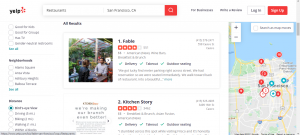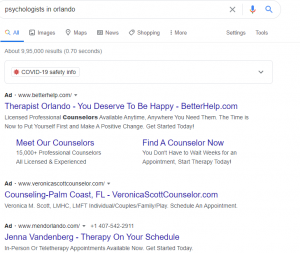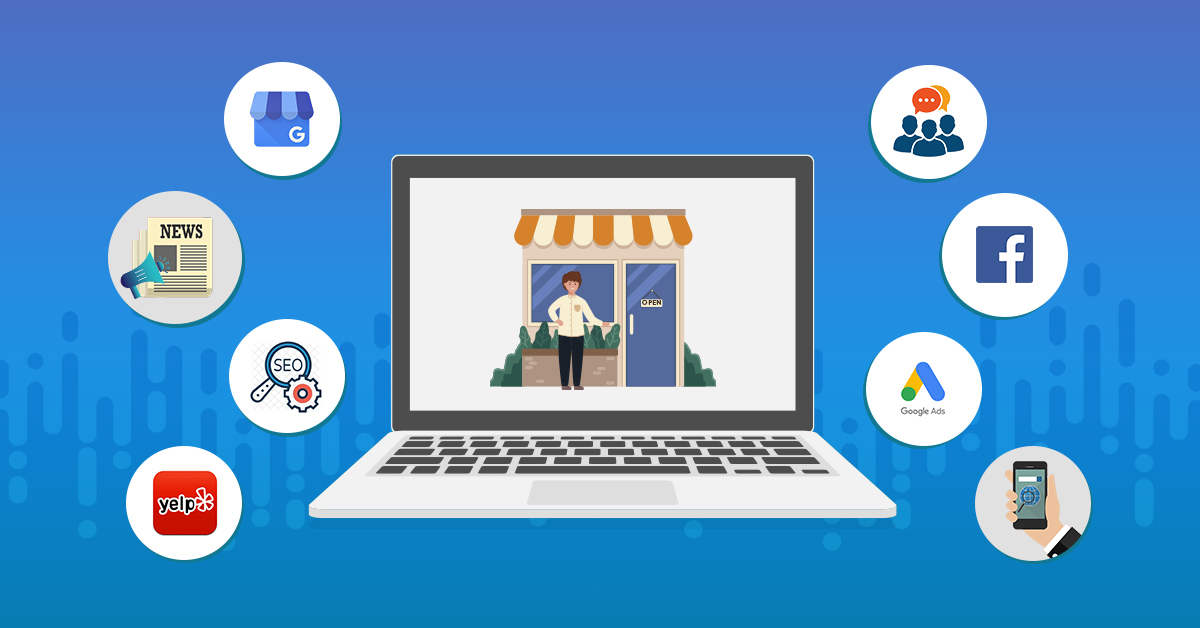The right Local Marketing strategies have the power to significantly improve your customer acquisition, retention and engagement rates without burning a hole in your pocket.
When you need to find a good restaurant or a gym or any other service in your area, what do you do? You use the internet.
Like you, millions of people around the world use the internet to find local businesses. In fact, 46% of all Google searches are now based on local intent.
So, if you own a local business whether it is a small café or a chain of salons spread across the city, your customers are looking for you on the internet. And to be able to reach and woo them, you need some well-thought-out local online marketing strategies.
Understanding Local Marketing and its Need
Before discussing the strategies, let’s quickly discuss what is local marketing?
In the simplest terms, “it is a marketing strategy used by business establishments in order to target and acquire customers in a local area.” In most cases, the target market is limited to a 50-mile radius of the physical location of the business.
Generally speaking, local business marketing (as it is often called) is required by brick-and-mortar businesses that cater to local customers. Think local café, restaurant, book shop, bakery, doctor’s practice, salon, gym, and so on.
But from time to time, even online stores and multi-national brands might need to apply some local marketing tactics if they want to target a customer base located within a limited geographical area for some or all of their offerings.
This blog, however, focuses solely on small and medium sized local businesses.
Local marketing happens offline as well as online. But with 93% of consumers using the internet to search for the local businesses, we will be focusing on online local business marketing strategies.
Local Marketing Strategies
Here is a list of online marketing strategies that small and medium sized businesses can apply in order to target and acquire local customers.
1. Website Localization
61% of mobile searchers will contact a local business only if it has a mobile-friendly website.
Invest in localizing your website and making it mobile-friendly to get more relevant website traffic.
You already have a website. But that’s not enough.
To be able to target the customers in a specific neighborhood, it is important to localize the website. The following tactics will help you:
- Customize the website content and language for the local audience
- Use long-tail keywords specific to the target location
- Use the local cultural references in your content
- Make your website mobile-friendly and responsive.
Tools like Moz and KWfinder and Google Auto-Suggest can help you find long-tail keywords for your business.
2. Local Citation Management
List your business on online directories and other listing sites to be found by your target customers.
Local Citation refers to any online mention of location-specific information like name, address and phone number (NAP) of a business.
The main purpose of local citations is to improve the discoverability of a business. it also helps in creating backlinks which might prove beneficial to Local SEO. However, many SEO specialists believe that the contribution of citations in improving SEO of a website is rather limited.
A business can be cited on local business directories, websites, apps and social media platforms. You can list your business in the following three categories:
Major Platforms for all businesses:
These are the major platforms where businesses of any nature can list themselves. Examples include Google My Business, Bing, Yahoo Local, Foursquare, Acxiom, Yelp, Yellow Pages, Better Business Bureau, Super Pages, Apple Maps and many more. For example if someone is looking for a restaurant in San Francisco on Yelp, they can find the listed restaurants as shown in the image.
Finding Nearby Restaurants on Yelp. Click image to view Industry Specific or Area Specific Platforms:
As the name suggests, these are the websites, online directories and apps that are either specific to a location or to an industry. For example, Zomato and Allmenus are specific to the restaurant business, travel businesses have TripAdvisor, doctors have HealthGrades and Medicare.gov and so on.Unstructured Citations:
These are basically the mentions of a business on any website or app that isn’t specifically built for listing businesses. For example, mentions in local news sites or blogs, govt. databases etc.
However, just listing your business isn’t enough, data accuracy and consistency is of paramount importance. Ensure that there is no discrepancy in the NAP information across all platforms.
Tools like Moz Local, Yext, WhiteSpark and Synup are helpful in managing local citations.
3. Local SEO
60% of mobile users have contacted a business directly through the search results and 78% of location-based searches result in offline purchases.
Optimize your on-page and off-page SEO to increase traffic to your website and your business establishment.
Local SEO simply means optimizing your website for your target location so as to increase your Search Engine Results Page (SERP) rankings for local services. It can be categorized as On-page SEO and Off-page SEO.
On page SEO:
It involves all the activities that a business can perform within the website to achieve higher SERP rankings. Following tactics can help improve local SEO:
- Optimize content for local audience
- Improve the internal linking structure.
- Optimize the URL, title tags, headers and meta description for each item of the website content for the local audience.
- Use geo-targeted keywords
- Add a location page
- Use Featured Snippets
Off Page SEO:
It is creating backlinks for your business from reputable websites and pages. The quality as well as the quantity of the backlinks matter in building the domain authority of a website. This, in turn, leads to higher page ranks. Tactics you can use to get backlinks:
- Local citation: Get listed on Google My Business, Yahoo, Bing, Foursquare, Manta, Yelp and other directories.
- Social bookmarking: Use Twitter, Reddit, Pinterest, etc. to bookmark your website.
- Guest blogging: Submit your guest blogs on reputed local blogs
- Local podcasts: Participate in local podcasts relevant to your industry
- Local Industry trade publications: Publish your articles or research in local trade publications like NY Medical Journal for doctors
- Press releases: Use local news sites and online publications for press releases
Tools like Moz Local, Bright Local and SEMrush can help you in improving your Local SEO.
4. Local PR and Community Engagement
People usually prefer local businesses simply because they consider them to be a part of the community. As a local business, you can become a meaningful and essential part of the community with the following tactics:
- Organizing/sponsoring Events: Organize or sponsor physical as well as virtual events. For example, a local doctor can organize, sponsor or be a part of a blood donation drive or a virtual Cancer Awareness workshop for the community. Similarly, a local restaurant or a bakery can set up food banks for the homeless people of the area. Alternatively, you can sponsor local events like an inter-school football match or a local fair or organize an informative webinar for the local youth.
- Local PR: Leverage the local online media, news sites and local newspapers. For example, you can publish blogs on websites that cater to the people living in their target location. Or advertise the grand opening of your business, say a salon or a clinic, in the local newspaper. Businesses can also distribute Discount coupons with the local newspapers or news sites.
Tools like HubSpot CRM can help you in managing your Local PR
5. Leveraging Social Media for Local Marketing
Use social media to engage with your local customers in order to earn their trust.
Social media is a very powerful tool and businesses can use it to engage with local customers. Following are some of the tactics that can help a you in doing so.
- Set a location on your business’s social media profiles.
- Tag the location on each of your posts.
- Use hyperlocal keywords in your bios, hashtags and posts.
- Engage with the local audience by creating online contests, posting about important local events, answering questions and collaborating with local celebrities.
For example, a local salon can hold an online beauty contest on Instagram where it asks the women of the area to post their pictures with relevant hashtags and tag the salon. And the winner will get a Free hair care at the salon. This will help the business to instantly engage with the target customers while simultaneously creating a buzz for your brand without it costing too much.
Apart from the popular social sites like Facebook, Instagram, Twitter, local businesses can use upcoming sites like Nextdoor for hyperlocal marketing.
6. User Generated Content
Encourage your customers and employees to create and share content related to your business to increase your credibility.
User Generated Content (UGC) is basically any business-related content that is created by consumers. It includes content shared by users on social media, review websites and various forums. User Generated Content leads to better customer engagement. Moreover, it builds consumer trust and helps a brand reach more people in a cost-effective way.
Tactics you can use to encourage creation of User Generated Content:
- Reviews: 88% of local customers trust online reviews. Encourage your customers to write online reviews about your brand on your website, social media as well as third-party review sites like Yelp or TripAdvisor. Give incentives like Coupons or Discounts or Loyalty points in order to motivate customers to write reviews.
- Hashtag Campaigns: Create unique and location specific hashtags. And encourage local consumers to use those hashtags by offering prizes and hosting contests. For example, a local pizzeria in Chicago can create the #chicagodeepdishpizza and ask its followers to post the pictures or videos of their favorite deep dish pizza toppings with the hashtag. The picture or video with most likes gets a Free Deep-dish Pizza with their favorite toppings.
- Video Content: Encourage your customers to create and share brand related videos by giving them some kind of incentives. For example, a restaurant can ask local food bloggers to create a video about their food. Similarly, you can ask your customers to create video testimonials and share them on their social media.
Tools like Wishpond, Taggbox, Shortstack, TINT and Stackla can help you in collecting, monitoring and sharing UGC. Some of these tools also help in creating online contests, giveaways, etc. to encourage people to create UGC.
7. Local Advertising
Localize your digital ads for efficient results and lower Ad Spend.
While most of the local marketing strategies are inbound, some outbound efforts are also required. The most effective outbound local marketing strategy is to apply location-specific targeting in both search as well as social media advertising. Use the following tactics:
- Google Local Services Ads: It helps a business to feature on the top of the local search results. For example, a Psychologist practicing in Orlando uses this feature. Now, when someone types “Psychologist in Orlando” in Google, their ad will appear on the top as shown in the image.

Google Results for Psychologist in Orlando. Click the image to view - Localizing PPC: Add location-specific keywords and local lingo in the ad copy and use location-based targeting for PPC ads on Google.
- Localize social media advertising: Use Facebook Hyperlocal Ads. It ensures very specific targeting. It allows a business to narrow down the audience based on zip codes, area codes, age, gender, xx-mile radius etc.
Tools like Yooda and AdEspresso can help you in testing the Ads and monitoring the traffic. Additionally, tools like Geofencing can help in better targeting and improving click-through-rates for mobile advertising.
Summing up
With the number of local searches increasing day by day, it is time that small and medium businesses like doctors’ practices, restaurants, salons, spas, gyms, workshops, apparel stores and others invested in online local marketing strategies.
These strategies are extremely cost-effective as most of them are inbound activities. Moreover, local marketing and advertising have a very high ROI due to their narrow targeting. These strategies don’t just increase website traffic, but also build customer trust and foster customer engagement. All this translates into higher customer acquisition, retention and brand loyalty.
If you own a small or medium sized local business, you need to start thinking about local marketing. There are a plenty of online tools you can use. But, if you are short on staff or time, you can outsource local marketing without it costing you a fortune.
